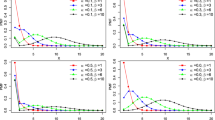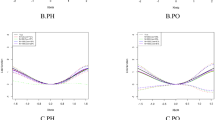Abstract
An estimation for censored quantile regression models, which is based on an inverse-censoring-probability weighting method, is studied in this paper, and asymptotic distribution of the parameter vector estimator is obtained. Based on the parameter estimation and asymptotic distribution of the estimator, an empirical likelihood inference method is proposed for censored quantile regression models and asymptotic property of empirical likelihood ratio is proved. Since the limiting distribution of the empirical likelihood ratio statistic is a mixture of chi-squared distributions, adjustment methods are also proposed to make the statistic converge to standard chi-squared distribution. The weighting scheme used in the parameter estimation is simple and the loss function is continuous and convex, and therefore, compared with empirical likelihood methods for quantile regression models with completely observed data, the methods proposed in this paper will not increase the computational complexity. This makes it especially useful for data with medium or high dimensional covariates. Simulation studies are developed to illustrate the performance of proposed methods.
Similar content being viewed by others
References
Backer MD, Ghouch AE, Keilegom IV (2018) An adapted loss function for censored quantile regression. J Am Stat Assoc. https://doi.org/10.1080/01621459.2018.1469996
Beran R (1981) Nonparametric regression with randomly censored survival data. Technical report, University, California
Gill Richard (1983) Large sample behaviour of the product-limit estimator on the whole line. Ann Stat 11(1):49–58
Huang J, Ma S, Xie H (2007) Least absolute deviations estimation for the accelerated failure time model. Stat Sin 17(4):1533–1548
Hunter DR, Lange K (2000) Quantile regression via an mm algorithm. J Comput Graph Stat 9(1):60–77
Owen A (1990) Empirical likelihood ratio confidence regions. Ann Stat 18(1):90–120
Owen A (1991) Empirical likelihood for linear models. Ann Stat 19(4):1725–1747
Pollard D (1990) Empirical processes: theory and applications. Hayward, California
Portnoy S (2003) Censored regression quantiles. J Am Stat Assoc 98(464):1001–1012
Powell JL (1984) Least absolute deviations estimation for the censored regression model. J Econ 25(3):303–325
Qin G, Tsao M (2003) Empirical likelihood inference for median regression models for censored survival data. J Multivar Anal 85:416–430
Rao CR, Zhao LC (1993) Asymptotic normality of LAD estimator in censored regression models. Math Methods Stat 2:228–239
Tang L, Zhou Z, Wu C (2012) Weighted composite quantile estimation and variable selection method for censored regression model. Stat Probab Lett 82(3):653–663
Wang HJ, Wang L (2009) Locally weighted censored quantile regression. Publ Am Stat Assoc 104(487):1117–1128
Wang QH, Li G (2002) Empirical likelihood semiparametric regression analysis under random censorship. J Multivar Anal 83(2):469–486
Wu CF (1981) Asymptotic theory of nonlinear least squares estimation. Ann Stat 9(3):501–513
Xie S, Wan ATK, Zhou Y (2015) Quantile regression methods with varying-coefficient models for censored data. Comput Stat Data Anal 88:154–172
Ying Z (1989) A note on the asymptotic properties of the product-limit estimator on the whole line. Stat Probab Lett 7(4):311–314
Ying Z, Jung SH, Wei LJ (1995) Survival analysis with median regression models. J Am Stat Assoc 90(429):178–184
Zhong P, Cui H (2010) Empirical likelihood for median regression model with designed censoring variables. J Multivar Anal 101(1):240–251
Zhou L (2006) A simple censored median regression estimator. Stat Sin 16(3):1043–1058
Zhou M (1991) Some properties of the kaplan-meier estimator for independent nonidentically distributed random variables. Ann Stat 19(4):2266–2274
Zhou M (1992) M-estimation in censored linear models. Biometrika 79(4):837–841
Zhou XQ, Wang JD (2004) A genetic method of LAD estimation for models with censored data. Comput Stat Data Anal 48(3):451–466
Zhou XQ, Wang JD (2005) LAD estimation for nonlinear regression models with randomly censored data. Sci China Ser A 48:880–897
Author information
Authors and Affiliations
Corresponding author
Additional information
Publisher's Note
Springer Nature remains neutral with regard to jurisdictional claims in published maps and institutional affiliations.
Appendix: Assumptions and Proofs
Appendix: Assumptions and Proofs
In this section, we will first state the three conditions used in the proposed theorems.
-
C1.
The distribution of \(\epsilon _i\) has unique \(\tau \)th quantile zero and its density function \(f(\cdot )\) is uniformly continuous at zero and satisfies \(f(0)> 0\).
-
C2.
\(\{X_1, \ldots , X_n\}\) are independent and identically distributed bounded random vectors.
-
C3.
The censoring variables \(\{C_i, i=1, \ldots , n\}\), which are independent of \(\{T_1, \ldots , T_n\}\), are independent and identically distributed with continuous distribution function G(t) which satisfies
where \(\tau _H=\sup \{t:[1-F(t)][1-G(t)]>0\}\).
Remark 1
The identical distribution of \(\{\epsilon _i, i=1, \ldots , n\}\) is not necessary in this paper and condition C1 can be replaced by
C1*. The distribution of \(\epsilon _i\) has unique \(\tau \)th quantile zero and its density function \(f_i(\cdot )\) is uniformly continuous at zero. Moreover, there is a positive number a such that \(\inf \limits _i f_i(0)\ge a> 0\) holds true.
The proposed theorems will still hold true under conditions C1*, C2 and C3.
In condition C2, we assume \(\{X_i\}\) are bounded as Ying et al. (1995) and Qin and Tsao (2003) did in their papers. Actually, The boundedness of \(\{X_i\}\) can certainly be true in practical applications, though it looks disgusting. The boundedness of \(\{X_i\}\) can be relaxed and replaced by some condition on the moment of \(X_i\).
Though both C1 and C2 can be relaxed, we apply them in this paper to simplify the notations in our proofs.
Remark 2
C3 is a condition about the behavior of G(t) and F(t) near \(\tau _H\), and it obviously holds true if \(\tau _F<\tau _G\). If \(\tau _G\le \tau _F\), since \(\frac{\delta _i}{1-G(Y_i)}\) will be large for any observed \(T_i\) near \(\tau _H\), from (3) and (4) we can see that an individual with observed \(T_i\) which is close to \(\tau _H\) will have large influence on the parameter estimator and confidence region. Therefore, C3 is an assumption to prevent too many such observation from appearing in the data, and therefore to ensure the asymptotic properties of proposed methods.
Then, before proving the theorems, we establish the following lemma, which is essential to the proofs of proposed theorems.
Lemma 1
Under conditions C1-C3 we have
holds true.
Proof
Let \(Q(t)=\frac{1}{n}\sum \limits _{i=1}^n\left[ \tau -I(Y_i<\beta _\tau ^TX_i) \right] I(Y_i\le \min (C_i,t))X_i\). By the martingale integral representation for \(\frac{{\hat{G}}(t)-G(t)}{1-G(t)}\) (Gill 1983; Ying 1989; Zhou 1991) we have
where \(M(s)=\sum \nolimits _{i=1}^n\left[ I(Y_i\le s, \delta _i=0) -\int _{-\infty }^sI(Y_i\ge v)d\varLambda (v)\right] \) and \(\varLambda (\cdot )\) is the cumulative hazard function of censoring variable \(C_i\).
Since
converge to q(s) uniformly in s, we have
where
Thus we have
Note that \(\{\eta _i(\beta _\tau )+\xi _i, i=1, \ldots , n\}\) are independent and identically distributed with mean zero. To obtain the limit distribution of \(\frac{1}{\sqrt{n}}\sum \nolimits _{i=1}^n{\hat{\eta }}_i(\beta _\tau )\) by the central limit theorem, we will calculate the variance matrix of \(\eta _i(\beta _\tau )+\xi _i\) in the following.
It is obvious that \(var(\eta _i(\beta _\tau ))=\varLambda _1\). For the variance of \(\xi _i\) we have
By direct calculation we deduce
where \(a_i=\frac{\delta _i}{1-G(Y_i)}\left[ \tau -I(T_i<\beta _\tau ^TX_i)\right] \). Noting the facts that \(E\eta _i(\beta _\tau )=0\), \(a_iI(Y_i\le s, \delta _i=0)=0\) and \(E\left[ a_iI(Y_i\ge s)X_i\right] =q(s)\) hold true, we obtain
Thus we have \(var\left[ \eta _i(\beta _\tau )+\xi _i\right] =\varLambda _1 -\varLambda _2\). Therefore, by central limit theorem we have Lemma 1 holds true. \(\square \)
Proof of Theorem 1
To prove Theorem 1, we define a new variable \(z=\beta -\beta _\tau \), and then rewrite the objective function of (3) as a function of z and denote it as \(U_n(z, {\hat{G}})\), that is,
Let
where
It is obvious that both \(S_n(z)\) and \(U_n(z,{\hat{G}})\) are minimized at the same point \({\hat{z}}_n={\hat{\beta }}_n-\beta _\tau \). Note that \(S_n(z)\) is a convex function of z. In the following, we will prove the asymptotic normality of \({\hat{z}}_n\) by analyzing properties of \(S_n(z)\).
Noting that
holds for any \(x, y\in R\), therefore we have
where
That is
Using (9) again we have
where
and
Next, we will prove \(S_{n1}^2=o_p(||z||^2)+o_p(1)\) holds true. To do this, we will first define \({\widetilde{Q}}(t)=\frac{1}{n}\sum \nolimits _{i=1}^n\left( z^TX_i-\epsilon _i\right) \left[ I(\epsilon _i<z^TX_i)-I(\epsilon _i<0)\right] I(T_i\le \min (C_i,t))\) and then apply the martingale integral representation for \(\frac{{\hat{G}}(t)-G(t)}{1-G(t)}\) again. As a result we have
To calculate \(S_{n1}^2\), on one hand, since
is the mean of independent and identically random variables, by the law of large numbers we have
holds uniformly in s, where \(A_i\) is the interval \((0, z^TX_i]\) or \((z^TX_i, 0]\) depends on \(z^TX_i>0\) or not. Therefore we have
On the other hand, noting that \(\frac{1}{n}\sum \limits _{j=1}^n \int _{-\infty }^{+\infty }\frac{dI(Y_j\le s,\delta _j=0)-I(Y_j\ge s)d\varLambda (s)}{h(s)}\) is also the mean of independent and identically random variables and
holds true, we have
Therefore \(S_{n1}^2=o_p(||z||^2)+o_p(1)\) holds true. Combining this with Eq. (11) we know
By Eqs. (8), (10) and (12) together we obtain
This means the unique minimal point of \(S_n(z)\) is
Combining this with Lemma 1 we have Theorem 1 proved. \(\square \)
To prove Theorem 2 , we need two more Lemmas as stated in the following.
Lemma 2
Under the conditions C1-C3, we have
Proof
By the factors (Zhou 1991)
for any \(\alpha \in R^k\) satisfying \(||\alpha ||=1\), we have that
Since
holds true for some positive \(C_0\) which is large enough, by condition C3 we have \(\frac{1}{n}\sum \limits _{i=1}^n\alpha ^T\left[ {\hat{\eta }}_i(\beta _\tau ) {\hat{\eta }}_i(\beta _\tau )^T-\eta _i(\beta _\tau )\eta _i(\beta _\tau )^T\right] \alpha =o_p(1)\) holds true. This complete the proof of Lemma 2. \(\square \)
Lemma 3
Under conditions C1-C3 we have
Proof
(a) holds true by Lemma 3 of Wu (1981). (b) and (c) follow directly from Lemma 1, Lemma 2, and the same arguments used in Owen (1991). We will omit details of the proof. \(\square \)
Proof of Theorem 2
By Lemma 3 we know \(\max \limits _{1\le i\le n}|\lambda ^T{\hat{\eta }}_i(\beta _\tau )|=o_p(1)\) holds true, thus
where
for some positive C. By Lemma 2 and Lemma 3 we obtain
Therefore,
holds true. Combining above equation with Lemma 1 and Lemma 2 we have Theorem 2 proved. \(\square \)
Proof of Theorem 3
Let \(\varLambda _1(\beta )\) and \(\varLambda _2(\beta )\) stand respectively for the right hands of (5) and (6) after replacing \({\hat{G}}(\cdot )\) by \(G(\cdot )\). By properties of \({\hat{G}}\) and a proof similar to that used for Lemma 2 we can show
Since \({\hat{\beta }}_n=\beta _\tau +O_p(n^{-1/2})\) holds by Theorem 1 , we have
Noting that \(\varLambda _1(\beta _\tau )=\varLambda _1+o_p(1)\), combining this fact with Eqs. (13), (14) and (15) together we have \({\hat{\varLambda }}_1({\hat{\beta }}_n)=\varLambda _1+o_p(1)\) holds true.
To prove the consistency of \({\hat{\varLambda }}_2({\hat{\beta }}_n)\), we first define
Then we have
holds for all s. Therefore by properties of \({\hat{G}}\) and condition C3 we have
holds uniformly in s. On the other hand
holds for all s. Then by condition C1 and C3 we have
holds uniformly in s. By Eqs. (16), (17) and the fact that \(U(G,\beta _\tau ,s)=q(s)+o_p(1)\) we have
holds uniformly in s. Noting that \(\frac{1}{n}\sum \nolimits _{j=1}^nI(Y_j\ge s)=h(s)+o_p(1)\) holds uniformly, by Eq. (18) and the law of large numbers we have
holds true. This complete the proof of Theorem 3. \(\square \)
Proof of Theorem 4
By the proof of Theorem 3 we have both \({\hat{\varLambda }}_1(\beta _\tau )=\varLambda _1+o_p(1)\) and \({\hat{\varLambda }}_2(\beta _\tau )=\varLambda _2+o_p(1)\) hold true obviously. Therefore by Lemma 1 and the proofs of Theorem 2 we obtain
This complete the proof of Theorem 4. \(\square \)
Rights and permissions
About this article
Cite this article
Gao, Q., Zhou, X., Feng, Y. et al. An empirical likelihood method for quantile regression models with censored data. Metrika 84, 75–96 (2021). https://doi.org/10.1007/s00184-020-00775-1
Received:
Published:
Issue Date:
DOI: https://doi.org/10.1007/s00184-020-00775-1




